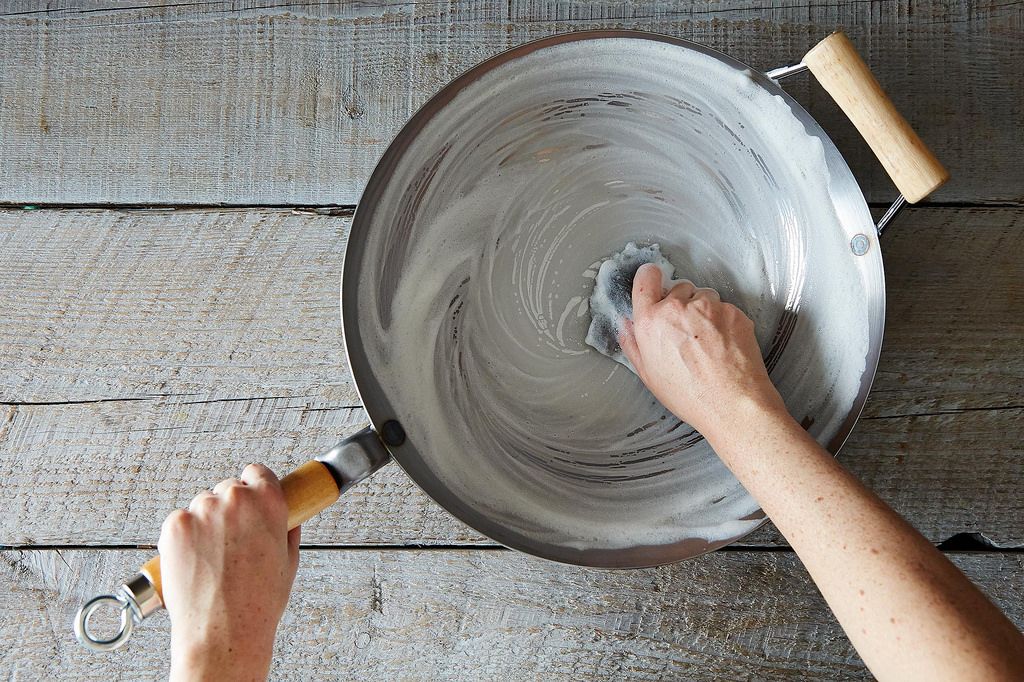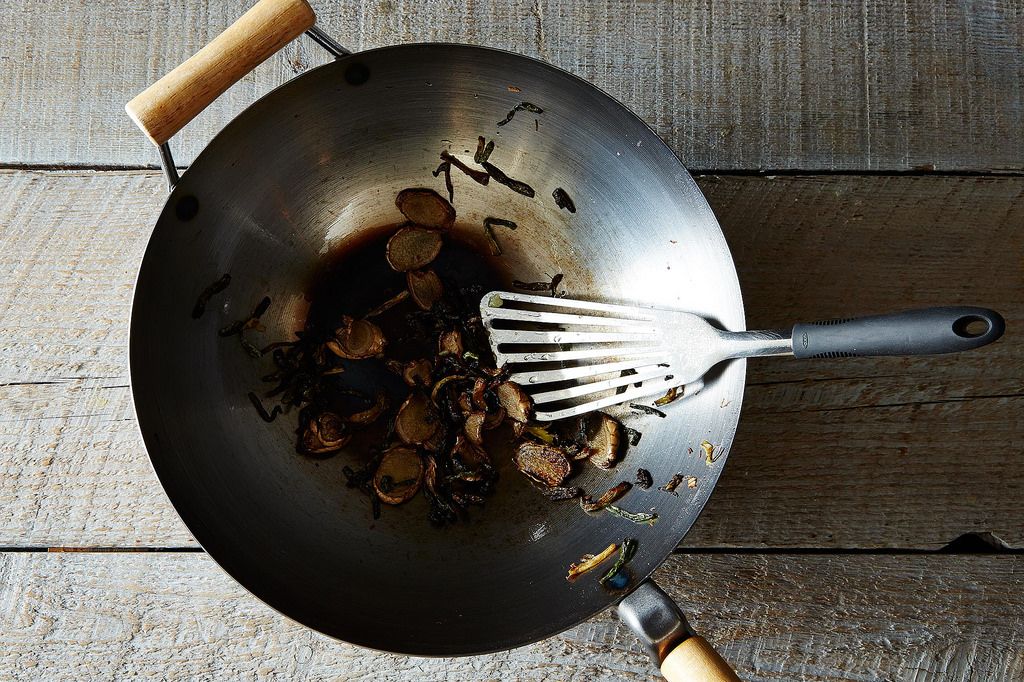
It's here: Our game-changing guide to everyone's favorite room in the house. Your Do-Anything Kitchen gathers the smartest ideas and savviest tricks—from our community, test kitchen, and cooks we love—to help transform your space into its best self.
Grab your copyPopular on Food52
Continue After Advertisement
20 Comments
natargyle
October 1, 2020
Will the stainless-steel scouring pad scratch the wok? I just purchased a wok and used a scotch heavy duty scouring pad and it scratched it all up. So I am buying another one and don't want to do it again.
e
June 30, 2019
Hi Grace, I have been using my carbon-steel wok now for a year or so and I think it's seasoned properly (not much sticks to it), however, when I heat it up initially (before adding oil), it smokes and makes the entire kitchen a bit smokey. Does this mean I should scrub it down with soap an re-season? Or is it supposed to do this? Thank you!
Grace Y.
July 7, 2019
Sorry to be late answering your question. When you heat your wok there should be a wisp of smoke but it should not smoke up your kitchen. My question to you is what kind of oil are you using to cook with? Is it a high smoking point oil like peanut, grapeseed, rice bran, safflower? You might be over-preheating your wok. Generally the wok is correctly preheated when the wok gives off a wisp of smoke or a drop of water evaporates within a second. There's no need to reseason. I suspect you are overheating your wok.
e
July 7, 2019
Hi Grace, we use canola oil. If we are over-preheating the wok, would the food burn fairly immediately? Maybe our choice of oil is the issue? Thank you for your help!
Grace Y.
July 7, 2019
Yes if the food burns immediately you are over-preheating your wok. Canola oil is fine for stir-frying. Can I ask you do you have a stove with average power or are you using a semi-professional range like a Wolf, Viking that has 15,000 to 20,000BTUs?
e
July 7, 2019
Sorry, our food never burns immediately. Just wondering if we *did* overeheat the wok, would it cause the food to burn immediately. I believe it might be about 10-12,000BTUs. Just concerned whether we are not cleaning the wok properly and that causes the smoking. there does not seem to be anything crusted on it. but if I rub a dry paper towel on it, it there will be some brown on the paper towel. Is that normal? Or should we scrub at it some more?
Grace Y.
July 7, 2019
If you over preheat the wok the aromatics like ginger/garlic will burn immediately. The best way to test if the wok is preheated correctly is to continually flick drops of water into the wok. The moment the drop of water evaporates within a second your wok is ready. Maybe try an oil with a higher smoking point than canola, like grapeseed or avocado or rice bran oil. You should clean your wok as you would a cast-iron skillet. Just hot water and a sponge is sufficient and then dry on low heat on the stove 1 to 2 mins or until there is no longer water in the pan. It's normal when you wipe the wok to have a little brown on the paper towel. You should look at my video on youtube. Search for Wok Therapist. :-)
aaron
June 10, 2018
Hi, Grace, thank you for this method. Unfortunately, I failed. My work looks like this now(pic: https://ibb.co/ghmKf8). How I can save this wok? Thanks!
Penny H.
November 13, 2017
Would this process work on iron skillets? It sounds a lot easier than coating the iron skillet in oil and baking it.
judy
July 15, 2016
I have learned to season my stainless steel using this method, and also her method for heating and oiling before each use. Far superior results. I have gone to stainless because I can no longer lift my cast iron pans-especially when full of food. The single handle is just not enough--I need both hands. But then the bigger the pot and the more the food, even that is though. I live my stainless steel, and made the best stir fry of my life using my stainless steel frying pan and this method.--still not Asian restaurant quality-but then I don't have the high heat or use that much oil! But so much better!
Jenny T.
August 26, 2015
Hi Grace, thank you for sharing this. This really amazing. I have been wasting money changing to a new wok every few years for not performing as it should be. Now I know I have been using it wrongly. Currently I have a stainless steel wok and I wonder if It should be seasoned the same way? Thanks again
e
June 20, 2015
Hi Grace, there is a wok seasoning video on wokshop that recommends baking the wok with a thin layer of oil (inside and out) in the oven before cooking with aromatics (chives) to treat the inside. What does this step do for the wok? I presume it is not necessary as your seasoning steps do not include it?
Grace Y.
June 20, 2015
In China, traditionally most homes did not have an oven. The most common way to season a wok was to stir-fry Chinese chives or scallions and ginger. I like this method as it's so simple. The baking method is more involved (as you have to wrap the handles in wet wash cloths and foil to protect them from burning but it does give a sturdier patina because the high heat burns the oil into the metal's pores.
Zelda
March 17, 2015
So the 'seasoning' is burnt oil? And what is the factory coating? Why do new woks not come with instructions to remove this? Why is it even on there if it needs to be vigorously scrubbed off? I cook a lot of Chinese food, but I'm not convinced about carbon steel woks.
Grace Y.
March 18, 2015
Zelda, Sorry I couldn't get to your questions sooner. All carbon-steel woks are sealed with a factory coating that prevents the pan from rusting. If the coating was not used the pan could rust just from the humidity in the air sitting in a warehouse or in a retail store. And of course, a rusted pan will not sell. Many wok manufacturers don't provide adequate instructions on how to remove the factory oil. I think it's horrible that they don't care to educate their customers on how to take care of their pans but... Every Chinese restaurant chef uses a carbon-steel wok. It heats quickly and cools down quickly so food is never overcooked; it conducts heat evenly and with use it develops a natural nonstick surface so that very little oil is needed for cooking. A high quality carbon-steel wok cost under $30 from the WokShop.com. I believe once you try it your cooking will never be the same.
I A.
March 18, 2015
This is very useful information. Thank you!
BTW, do you also suggest using your wok in a hot oven (450-500 degrees F) with the wood handle wrapped in a wet towel and that towel wrapped in aluminum foil? Me thinks that this could be a dangerous trick to try. I'd appreciate your thoughts. Again, thanks!
BTW, do you also suggest using your wok in a hot oven (450-500 degrees F) with the wood handle wrapped in a wet towel and that towel wrapped in aluminum foil? Me thinks that this could be a dangerous trick to try. I'd appreciate your thoughts. Again, thanks!
Zelda
March 19, 2015
Thanks for that, Grace. I have had a few carbon steel woks, none of which came with instructions about removing the protective coating!
Grace Y.
March 19, 2015
I've used my wok with wood handles in the oven---it makes a great roasting pan. You must uses wet wash cloths (I don't use towels because they're too big). And then wrap the wet cloths totally and tightly in aluminum foil. I've put the wok in an oven at 475 degrees for up to 45 mins. Longer and the cloths may dry out. You do have to be extremely careful when you remove the wok from the oven. I let the wok sit for about an hour before I carefully unwrap the aluminum foil. There is bound to be steam build up from the wet cloths and you can get a nasty burn if you unwrap the aluminum foil sooner.





See what other Food52 readers are saying.